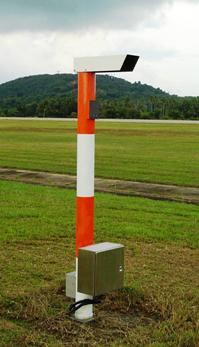Data processing
With the speed of fall and the size of the particles, it is then possible to determine the type of precipitation (rain falls much faster than snowflakes for example) with a contingency table. The detector will report the type of precipitation with the largest population in the samples. [2] However, in some cases, the characteristics of two types of precipitation may be similar (drizzle and snow fall at speeds very close to each other), or there may be a mixture of precipitation (e.g. rain and melting snow).
To refine detection in the event of ambiguity, these devices use the dew point temperature (or, if missing, environmental temperature) and the icing detector output. Thus, if the detector identifies the falling speed for the dual snow/drizzle at an ambient dew point greater than 1 °C (34 °F) it will classify it as drizzle, and below −1 °C (30 °F), it will be snow. [2] The icing detector will also be used to determine if rain or drizzle is freezing when the temperature is below freezing.
When these additional data still do not make it possible to differentiate (e.g. if the dew point of the previous example is between −1 and 1 °C), the type is then reported as "unknown". Thus at the moment, these devices cannot report hail, ice pellets, and various other intermediate forms of precipitation. [1] [2]
The instantaneous intensity of precipitation is calculated by the intensity of the scintillation (LED sensor) or the reflectivity (POSS). It is reported as very weak, weak, moderate or strong. [1] [2]



